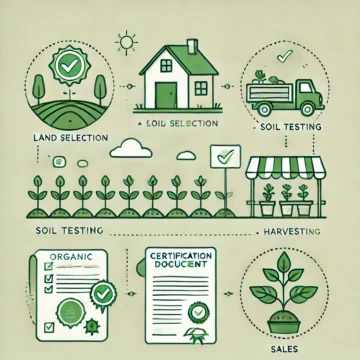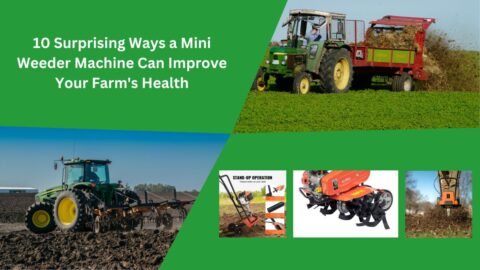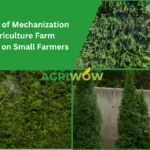The desire for fresh, healthy produce and a connection to nature is driving a growing interest in organic farming. Tools like farm water pump can enhance efficiency while promoting sustainable practices. Starting your organic farm can be a rewarding experience, providing you with sustainable food and a fulfilling lifestyle. This guide outlines the essential steps to get you started.
The journey begins with careful planning. First, assess your land. Consider the soil type, water availability, and sunlight exposure. Next, develop a comprehensive business plan. This should include your target crops, estimated costs, potential revenue streams, and marketing strategies. Research organic certification requirements in your region. This will help you understand the necessary practices and record-keeping needed to achieve official organic status. Start small and focus on a few key crops to gain experience and manage resources effectively. Build healthy soil through composting, cover cropping, and crop rotation. Finally, choose appropriate organic seeds or seedlings from reputable suppliers. Tools like a manual seeder machine can help streamline the planting process and increase efficiency.
Steps to Start Your Own Organic Farm
| Step | Description |
| Research & Planning | Study organic farming methods, market demand, and required certifications. |
| Choose Suitable Land | Select fertile soil with access to water and minimal chemical exposure |
| Obtain Organic Certification | Follow local organic farming regulations and certification processes. |
| Prepare the Soil | Use compost, natural fertilizers, and organic methods to enrich the soil. |
| Select Organic Seeds | Choose non-GMO and organic-certified seeds suited for your climate. |
| Implement Organic Practices | Use crop rotation, natural pest control, and sustainable irrigation |
| Set Up Farm Infrastructure | Install necessary facilities like irrigation systems, fencing, and storage. |
| Monitor & Maintain | Regularly check soil health, plant growth, and pest control measures. |
| Harvest & Store | Use organic harvesting techniques and proper storage to maintain quality |
| Marketing & Sales | Sell through local markets, organic stores, or online platforms. |
Process to Start an Organic Farm

Going Green: Why Organic Farming Is the Future
Organic farming offers numerous environmental and health benefits. It prioritizes soil health, reducing reliance on synthetic fertilizers and pesticides that can pollute waterways and harm ecosystems. Organic practices promote biodiversity by creating habitats for beneficial insects, birds, and other wildlife. By avoiding chemical inputs, organic farming produces healthier food with fewer residues, benefiting consumers and farmers alike. It also contributes to climate change mitigation by sequestering carbon in the soil. As consumer demand for sustainable and healthy food grows, organic farming is poised to play a crucial role in shaping the future of agriculture. Tools like a Mini Weeder Machine can improve farm efficiency and sustainability.
Soil Enrichment: The Foundation of Successful Organic Farming
Healthy soil is the cornerstone of any successful organic farm. It provides essential nutrients, water retention, and support for plant growth. Organic farmers prioritize building and maintaining soil health through various methods. Composting is a key practice, turning organic waste into a nutrient-rich soil amendment. Cover cropping involves planting specific crops to improve soil structure, fix nitrogen, and suppress weeds. Crop rotation involves alternating crops in a planned sequence to prevent nutrient depletion and pest buildup. These practices enhance soil fertility naturally, creating a thriving environment for plants. Additionally, tools like a brush cutting machine can help manage weeds and maintain farm cleanliness.
Marketing Your Organic Farm: Tips for Reaching Eco-Conscious Consumers
Effectively marketing your organic produce is crucial for success. Communicate the benefits of organic farming to consumers. Highlight the fresh, healthy, and environmentally friendly aspects of your products. Direct-to-consumer sales, such as farmers’ markets, farm stands, and Community Supported Agriculture (CSA) programs, offer opportunities to connect directly with customers and build relationships. Online marketing through social media, websites, and online marketplaces can expand your reach. Partnering with local restaurants, grocery stores, and food co-ops can create reliable wholesale channels. Emphasize transparency and traceability by sharing information about your farming practices and certifications. Building trust with consumers is essential for establishing a loyal customer base. Tools like the Neptune sprayer pump can demonstrate your commitment to high-quality and efficient farming methods, ensuring top-notch produce for your customers.
Starting an organic farm requires dedication and effort. By focusing on sustainable practices, building healthy soil, and effectively marketing your products, you can create a thriving business that benefits both your community and the environment. Whether it’s through using innovative tools like a brush cutter or connecting with consumers directly, every step you take contributes to a sustainable future.
FAQ
Q1. How to convert land into organic farming?
Planting of hedges, other crops, and/or agroforestry trees can be valuable to help establish a diverse farming system. Growing leguminous green manures provides nutrients to the soil. Green manures do not provide immediate income, but in the long term, they make the soil fertile and productive for the future.
Q2. Which is allowed in organic farming?
Organic farmers also use animal manure, certain processed fertilizers such as seed meal, and various mineral powders such as rock phosphate and green sand, a naturally occurring form of potash that provides potassium. In some case,s pH may need to be amended.










